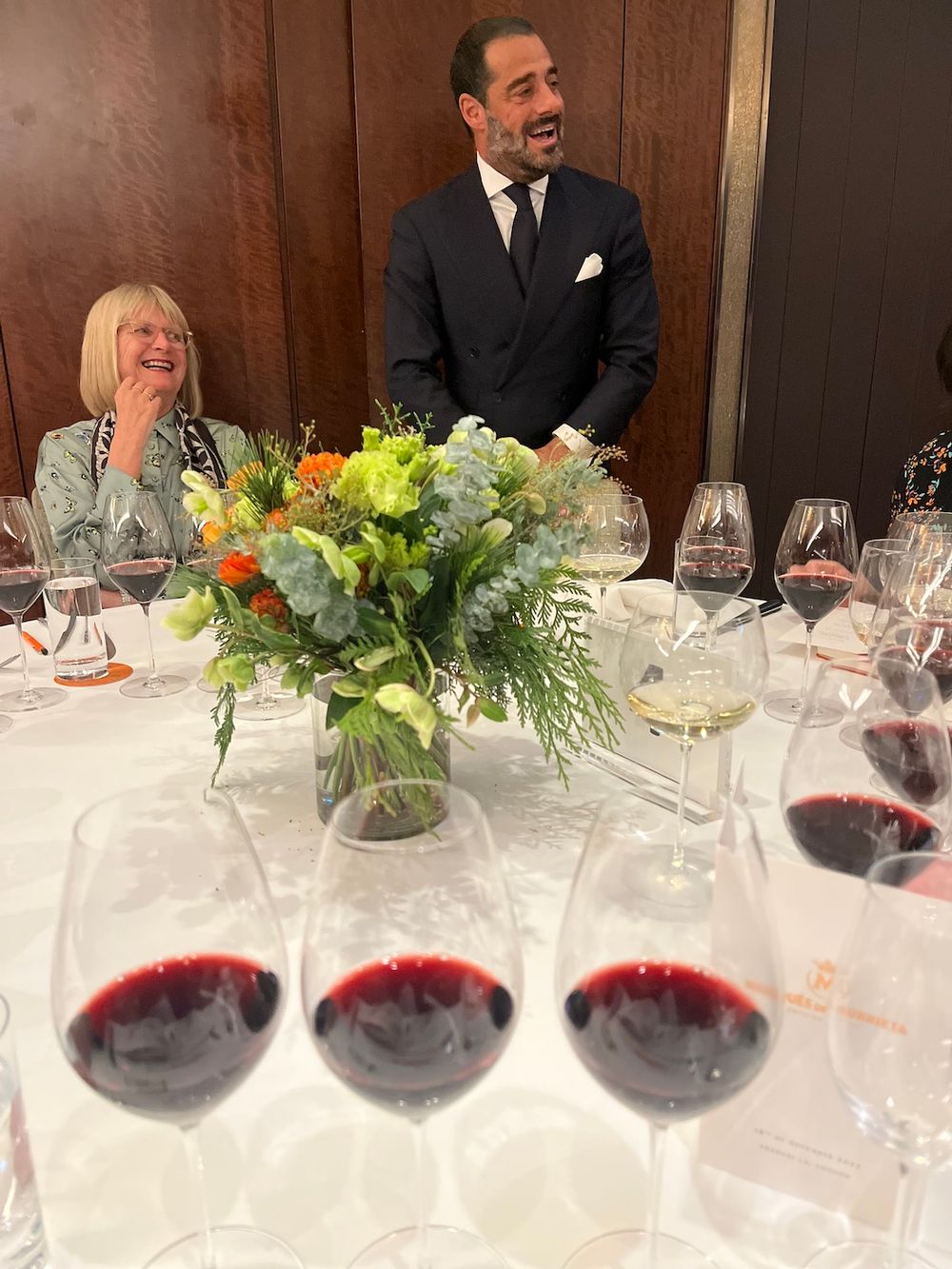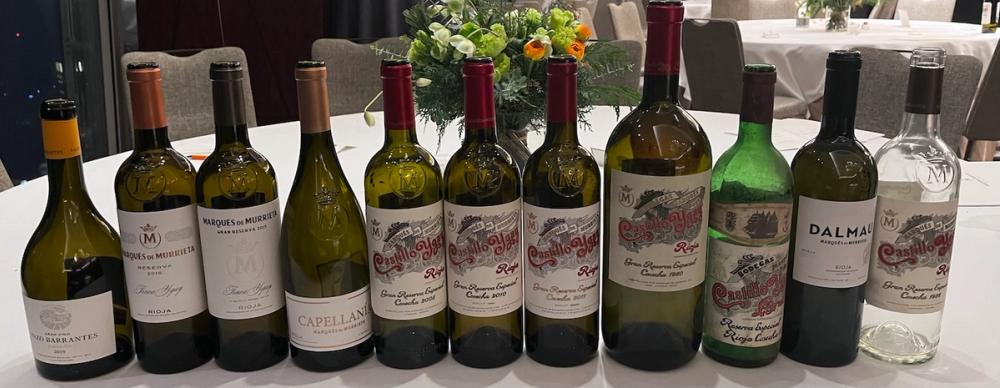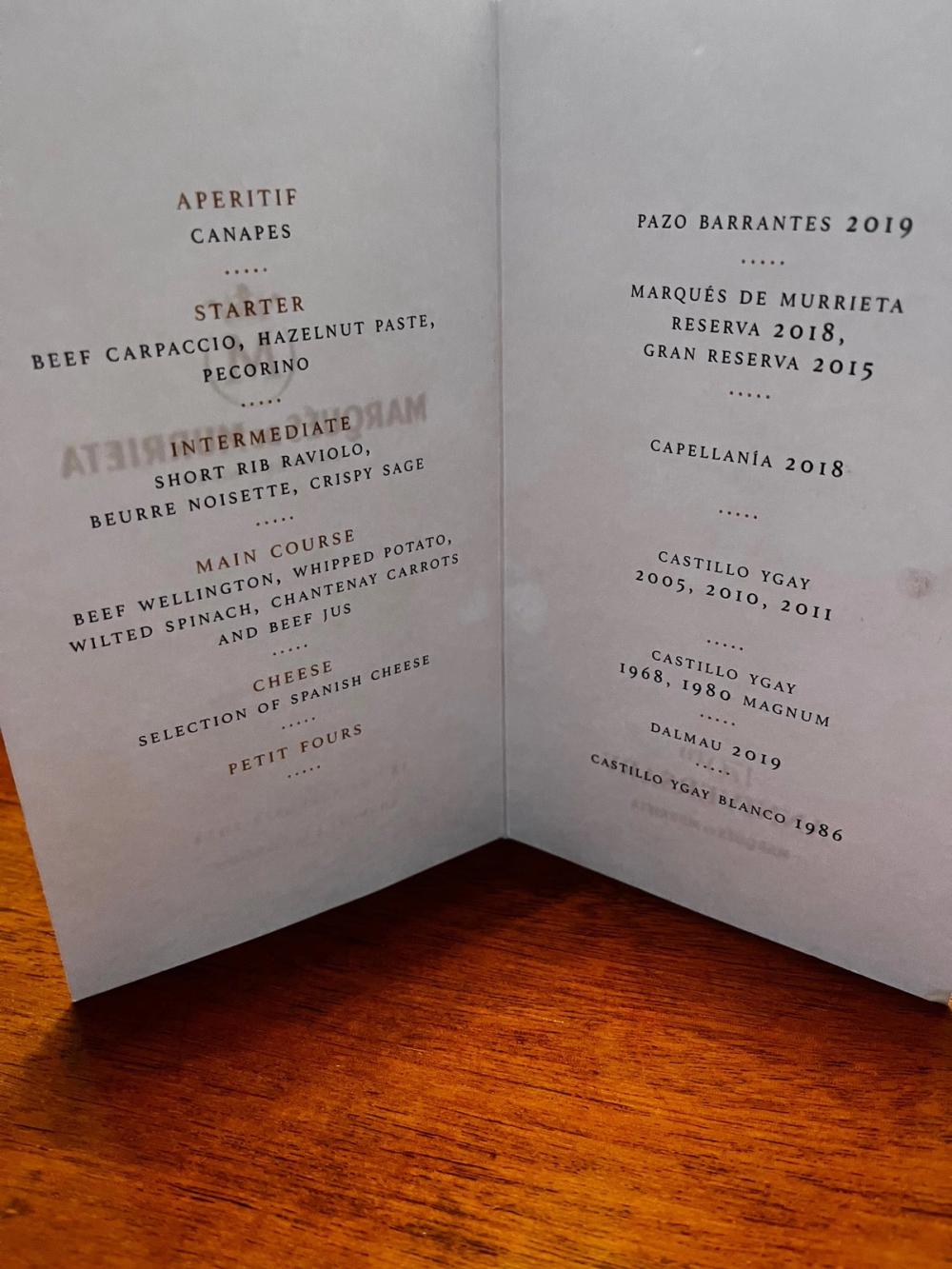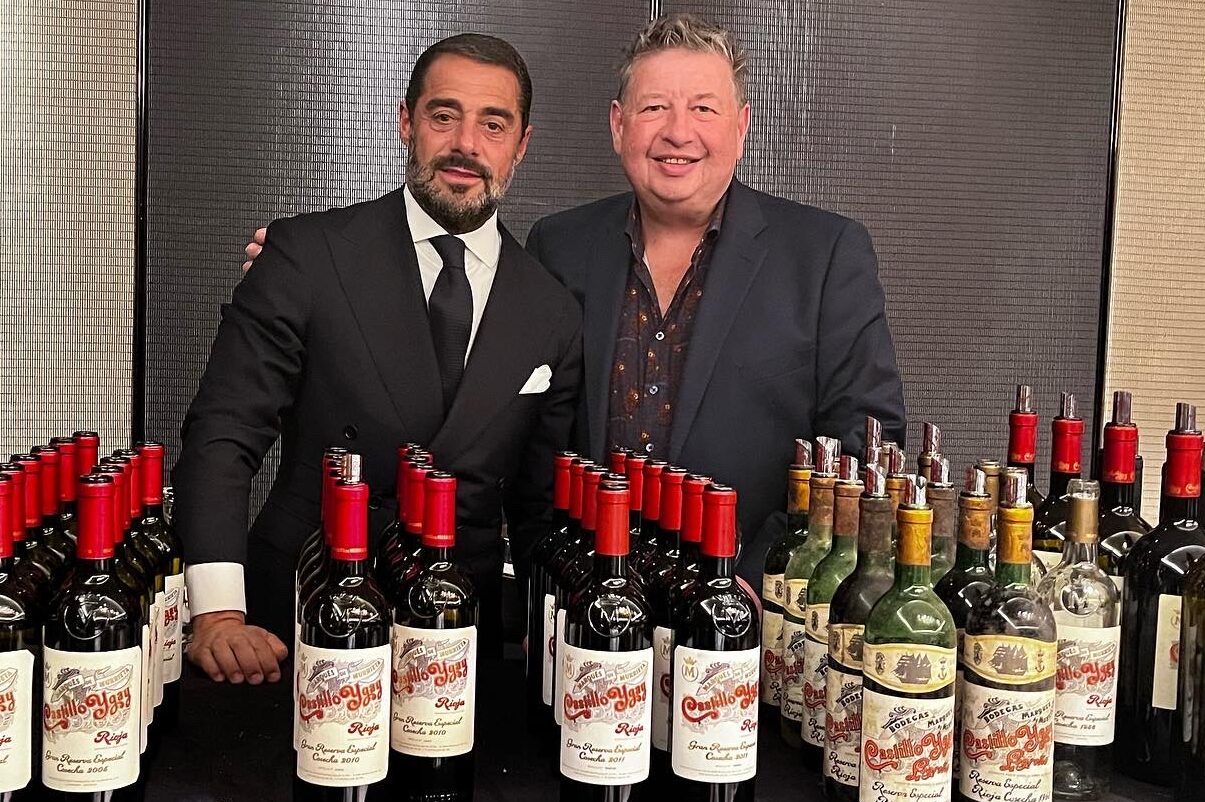“Marqués de Murrieta’s chief, Vicente Dalmau, sees a natural way forward for Rioja in making a Bordeaux class system, highlighting each bodegas’s status,” writes Jones.

Vicente Dalmau holds court at the Marqués de Murrieta 170th anniversary dinner
Vicente Dalmau is a brilliant speaker, his vision is no holds barred, as he continues to excel in building a world class brand, that has a wide global following. His sharp designer clothes and immaculate ‘presidential’ appearance is testament to everything he does in seeking perfection for his wines, but rest assured he is one of the nicest and friendly gentlemen that I have met.
Marqués de Murrieta is the oldest family-owned estate in Rioja, it was founded in 1852 by Luciano Francisco Ramón de Murrieta, one of the founding fathers of modern Rioja winemaking, who used French techniques to develop greater complexity and longevity from Tempranillo, sourced all grapes from a single estate and established the Ygay estate near Logroño in Rioja Alta. Luciano was made Marqués de Murrieta by Queen Isabel II, and after his death in 1911, the bodega was taken over by the Olivares family and then in 1983 by D. Vicente Cebrián-Sagarriga, Count of Creixell. The new owner sadly died in 1996 leaving his 24 year old son, Vicente Dalmau Cebrián-Sagarriga to run the estate.
From that day Vicente Dalmau was determined to start a wine revolution not only in Rioja but also in Rias Baixas – the estate now covers 300 hectares and the philosophy is one of quality, with low yields in the vineyard and limited production in the winery which are the key to the quality and style of Marqués de Murrieta wines. With his sister Cristina Dalmau has completely updated the historic Marqués de Murrieta winery, including the 3,000-square-metre granite buildings and also revived the Galician winery Pazo de Barrantes, showing the way forward for Albariño wine. They built up a new team, looked at getting the balance of fruit, freshness, purity and elegance into their wine, this was not to be an overnight change but things have been transformed slowly over the last 26 years.
Key to the changes has been winemaker María Vargas who joined the estate in 1995 as assistant winemaker and took the top position in 2000.
Dalmau stated that it was “important to showcase the new style”, with the 2018 vintage being an important step as he referred to it as “our new era”, and the wines as our “new babies”.
Dalmau is focused and determined and is also leading the way forward to educate the world about Rioja, he sees a natural way forward in making a similar Bordeaux class system, highlighting each bodegas’s status, he clearly thinks that the current system where “Gran Reserva” has no quality status is misleading. He said that having “Grand Reserva” on a label is misleading, and merely quantifies the age not the quality and therefore is not helpful to the consumer.
So how were the wines showing?

The line-up of wines in full
Gran Vino Pazo Barrantes, Albariño 2019 (served with canapés)
The winery in Galicia was built in 1991 in the heart of the DO Rias Baixas, with 12 hectares of vineyards, planted 100% with Albariño grapes, having an unique terroir and microclimate. This estate was originally owned by the Olivares family who owned Murrieta prior to Vicente’s father.
The wine is a step up from previous vintages that I have tried. The wine is fermented in stainless steel tanks for 60 days, then rests for two months on its lees. It then has seven months ageing – 85% in stainless steel tanks and the rest in 225-litre acacia barrels. The 2019 vintage was bottled in June 2020, and then aged for a further two years in bottle.
This is an Albariño with style, complexity and attitude which Vicente sees as the future for this wine. Vicente said that the Albariño grape “deserves” this new complexity, giving it more potential to age and therefore become a greater grape. The freshness, with a lemon and lime uplift, is there on the front palate, but underneath there are layers of flavours with white flowers, beautifully clean fruit, hints of texture and creaminess but with a fresh acidity. Quite outstanding.
The next nine wines were all served with dinner

Marqués de Murrieta Reserva 2018
86% Tempranillo, 8% Graciano, 4% Mazuelo, 2% Garnacha
Aged for 21 months in 225-litre American oak barrels, of which six months is in new oak, then a few months in 15,000-litre concrete vats prior to bottling.
Cocoa, mocha, juicy lamb, inky, peppery, polished, with delicate tannins still present but evolving.
Marqués de Murrieta Gran Reserva 2015
80% Tempranillo, 9% Graciano, 9% Mazuelo, 2% Garnacha
Aged for 27 months in 225-litre American oak barrels, of which six months is in new oak, then a few months in 15,000- litre concrete vats prior to bottling.
I loved the silky texture of this wine – dark, bright acidity, rich and ripe, classic Rioja flavours of blackberries, blueberries, violets, roast lamb’s blood, meaty but fresh, bright vanilla spice, polished cedar, hints of bonfire, fresh and clean on the finish. This wine retails from around £48 which offers exceptional good value for an 8-year-old wine of great quality that can be drunk now but will also evolve beautifully over time and age gracefully.
Marqués de Murrieta Capellanía White Reserva 2018
100% Viura
Fermented for 35 days in 9,400-litre concrete vats, prior to ageing for 22 months in 225-litre new French oak barrels, then a further 12 months in 15,000 concrete tanks.
Vicente calls this its ‘single estate’, he has been evolving this wine, seeking a ‘new era’ wanting more ‘balance, more fruit and the potential to allow it to age’, he certainly has achieved this with this impressively textured, focused and layered wine, sourced from vines dating back to 1945 on the 6 hectare Capellanía plot. A myriad of flavours dance on the palate – ripe, crisp, peeled Pear William, white cob nuts, almonds, hints of yellow nectarines – the wine having a full flavour but with a sublime freshness; will age beautifully.
This white was a perfect match to the Short Rib Ravioli, brightened up by the Beurre Noisette and Crispy Sage, highlighting how well white wine can go with rich meat dishes.
Marqués de Murrieta, Castillo Ygay 2005
89% Tempranillo, 11% Mazuelo
Castillo Ygay is made from grapes sourced from La Plana, a 30 hectare single vineyard planted in 1950, at the highest elevation of the Ygay estate. The Tempranillo is aged for 30 months in 225-litre American oak barrels, and part of the Mazuelo in 225-litre French oak barrels. The wine is then further in concrete tanks and bottle before release.
The Mazuelo is rather special to this wine, giving it acidity and freshness; the wine has notes of cocoa, spices, cherries, violets and game; textured and velvety, the flavours are luscious and linger on the palate.
Marqués de Murrieta, Castillo Ygay 2010
85% Tempranillo, 15% Mazuelo
Truffles, dried ceps, cedar, mocha, juicy raspberry freshness, milk chocolate, spiced; as the wine opens out in the glass there is a fresh, delicate and clean focus to it. This Ygay is starting to show immense class, I loved the balance between the savoury darkness and fresh uplift from the red berries and cherries.
Marqués de Murrieta, Castillo Ygay 2011
84% Tempranillo, 16% Mazuelo
This to me was even better than the 2010, dark with more concentrated fruits but with a cleaner freshness to it, giving a perfect balance; the was in perfect harmony with nothing ‘shouting out’, just perfectly poised. Wow what a wine! One that you need to hide in the cellar for a decade or two.
Marqués de Murrieta, Castillo Ygay 1980 (from magnum)
72% Tempranillo, 13% Mazuelo, 11% Garnacha Tinta, 4% Graciano
72 months aged in new and old 225-litre American oak barrels and 10 months in concrete vats.
The magnum that I tried was beautifully clean, fresh and focused, with an amazing hedonistic perfume to the nose; lamb blood juices, blue and black fruit but pure, there were some savoury flavours – meat and cedar – on the back palate, but overall the wine was fresh and focused with refined vanilla and spiced cocoa.

Marqués de Murrieta Castillo Ygay 1968
70% Tempranillo, 13% Mazuelo, 12% Garnacha Tinta, 5% Graciano
13 and a half years in old and new 225-litre American oak barrels, 6 months in concrete tank, and the rest of the time this wine is aged in bottle before release. The 1968 served to us was bottled in January 1983.
This was an outstanding wine and, if the 1980 was savoury, this was more fruit-driven – think perfect Scottish autumn raspberries; timeless, brilliant, pure and clean the purity is immense. When aged Rioja is this good it just glides down, drink it by itself or enhanced by a touch of aged Spanish manchego with quince jelly. What a treat
Marqués de Murrieta Dalmau 2019
86% Tempranillo, 10% Cabernet Sauvignon, 4% Graciano
Grapes are sourced from a 9-hectare single vineyard that was planted in the 1950s. Each grape variety is fermented separately in 225-litre French oak vats, before 20 months ageing in 225-litre new French oak barrels, and a further 6 months in 15,000-litre concrete vats.
Vicente set out a new vision with this wine; after his father’s death he wanted to “fill the emptiness that we had felt having lost our captain” and the new Dalmau wine would highlight the “New Captain.” He also said that he wanted to produce a Rioja which was more fruit dominant,
Dark fruited, aged Balsamic, spices, silky, olives, black cherries, violets, dark and brooding, the style has changed since its first release and certainly from memory is much more restrained now giving a perfect balance between fruit and savoury flavours.
Marqués de Murrieta, Castillo Ygay White 1986
97% Viura 3% Malvasia
252 months in 225-litre American oak barrels and 67 months in concrete tanks.
Sourced from the Capellanía 6-hectare single vineyard that was planted in 1945, this 1986 was first released in the UK in 2006, funnily enough at a tasting lunch held at St Pancras Clock Tower cooked by myself!
Textured and layered, sauce anglaise, vanilla spice, white peeled stone fruit, excellent purity and freshness, again the balance is pretty perfect. Bounty bars, buttery but fresh, hints of violets, cob nuts and cocoa – a rare treat.
The wines of Marqués de Murrieta are sold and distributed by Maisons Marques & Domaines
































